What is Document Management?
Document management is the process of creating, organizing, storing, and retrieving documents in both physical and digital formats. It covers the entire lifecycle of a document, from creation and use to archiving or disposal, ensuring that information is properly handled, secured, and accessible when needed.
This includes tasks like drafting a company policy, scanning purchase orders into a system, retrieving a signed contract, or archiving outdated reports.
Depending on the format, document management applies to:
- Physical documents: printed contracts, paper invoices, employee files, handwritten notes, medical records
- Digital documents: Word files, PDFs, scanned images, emails, e-signed contracts, cloud-based forms
Whether managed manually or through a Document Management System (DMS), effective document management helps businesses streamline operations, enhance compliance, and support collaboration across teams.
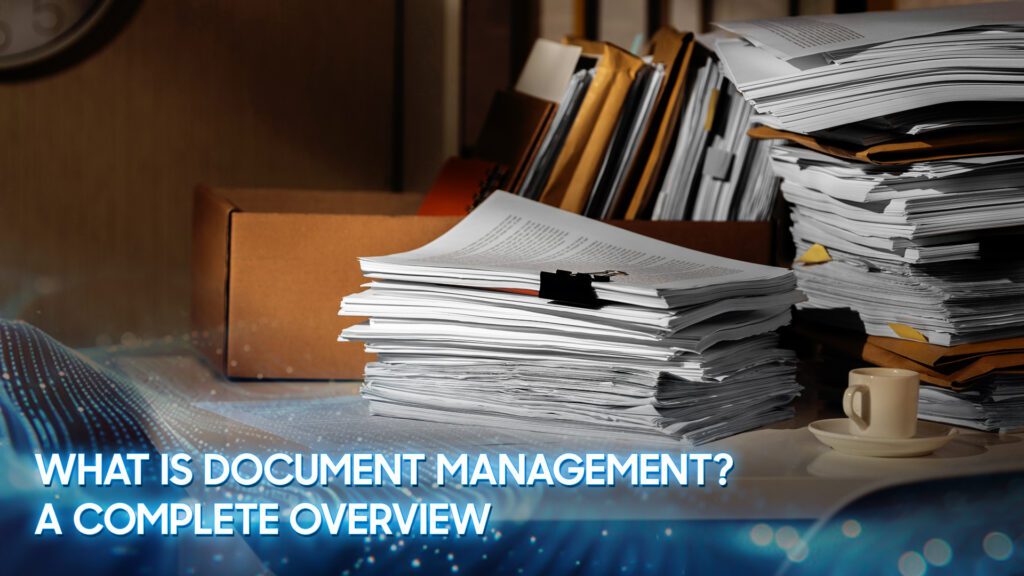
What is a Document Management System (DMS)?
A Document Management System (DMS) is a software solution designed to manage digital documents in a centralized, secure, and organized environment. It allows businesses to store, track, retrieve, and share documents efficiently across teams and departments.
Common features of a DMS often include version control, access permissions, full-text search, audit trails, and integration with other business systems such as ERP or CRM platforms. These functions help reduce manual handling, minimize errors, and ensure documents are managed in compliance with internal policies and industry regulations.
By replacing scattered file storage and manual processes, a DMS supports faster decision-making, improves collaboration, and provides better control over business information.
How to Manage Documents Efficiently
Effective document management is essential for any business looking to stay organized, reduce risk, and improve daily operations. Whether working with physical or digital files, managing documents well ensures teams can find what they need, avoid version errors, and maintain compliance. Efficient document management not only saves time but also cuts costs and supports long-term growth by giving companies better control over their information.
There is no one-size-fits-all approach to document management, and here’s how to manage documents effectively for both physical and digital documents.
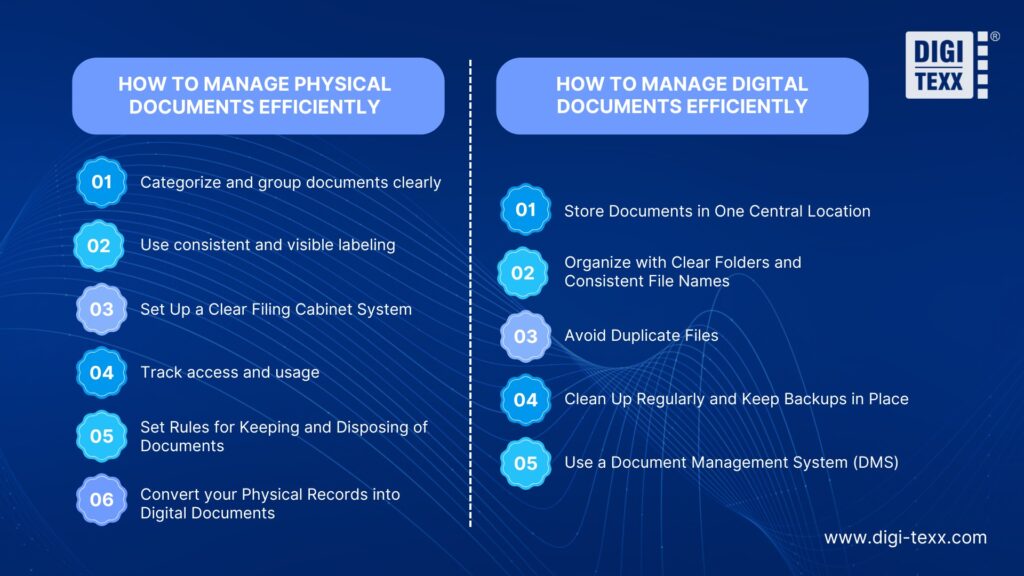
How to Manage Physical Documents Efficiently
Despite the shift to digital, many organizations still rely on physical documents, such as contracts, invoices, patient files, employee records, and more. These documents are often part of legal or operational requirements, and poor handling can lead to costly mistakes. Below are key practices for managing physical documents efficiently:
1. Categorize and group documents clearly
Organize documents by type (e.g., contracts, HR records), department, or date. Use color codes, indexing systems, or file codes to make storage and retrieval faster. A clear system minimizes confusion and helps new staff quickly understand the filing structure.
2. Use consistent and visible labeling
Label all folders, boxes, and binders clearly and uniformly. Each label should show what the document is, which department it belongs to, and the date or time range.
When everything follows the same format, it’s easier to find files, avoid mix-ups, and keep things organized, even when multiple people are involved.
3. Set Up a Clear Filing Cabinet System
Assign cabinets, drawers, or shelves to specific types of documents so everything has its place. Keep active files separate from archived ones, and consider using a simple map or log to show where each type of record is stored.
This helps prevent clutter, saves time when searching, and keeps important documents from getting lost.
4. Track access and usage
Use a logbook or borrowing form to record every time a paper document is taken out or used. Include details like who accessed it, when, and for what purpose.
This simple step helps prevent files from getting lost, keeps people accountable, and ensures important records are returned properly
5. Set Rules for Keeping and Disposing of Documents
Set clear rules for how long each type of paper document should be kept. Some records need to be stored for several years, depending on legal or business requirements. Others may only need short-term storage.
When a document is no longer needed, make sure it is disposed of in a secure way such as shredding or using a certified disposal service, to protect any sensitive or confidential information.
6. Convert your Physical Records into Digital Documents
Scanning and converting paper documents into digital format makes storage more efficient and improves long-term accessibility. Digitized files are easier to organize, search, share, and back up.
This also reduces the space and cost required for physical storage. While not all documents need to be digitized immediately, starting with high-use or high-risk files can help streamline operations and prepare for a future digital transition.
How to Manage Digital Documents Efficiently
As more organizations embrace hybrid and remote work, managing digital documents becomes increasingly important. Without structure, digital files can become just as chaotic as paper ones, scattered across emails, drives, and devices. Below are common ways to improve your digital document management:
1. Store Documents in One Central Location
Keep all files in one shared location that everyone on the team can access, like a cloud drive, server, or document platform. This avoids scattered files across personal devices or email threads, prevents version conflicts, and makes it easier to find and manage documents in one trusted space. A central hub also supports better collaboration and access control.
It also helps maintain a clear audit trail of who accessed or updated what. As your team grows, having a single source of truth becomes even more important for staying organized.
2. Organize with Clear Folders and Consistent File Names
Organizing digital documents with a clear folder structure and consistent file naming brings order, clarity, and control to your business information. When everyone knows exactly where to save documents and how to name them, it becomes easier to locate the right file, avoid duplicates, and reduce version confusion.
This approach not only saves time but also improves collaboration across departments, especially as your team grows or new members come on board.
To manage documents this way, start by setting a company-wide convention that covers:
- How to organize main folders and subfolders (by client, project, or department)
- A standard file naming format (e.g., Client_Project_Type_Date.pdf)
- Guidelines for updating and archiving old files
When consistently applied, this simple structure becomes a solid foundation for more advanced document management practices.
3. Avoid Duplicate Files
Duplicate documents can easily confuse and lead to people using the wrong version. When files are saved multiple times with slight differences, it becomes harder to know which one is correct. This can result in errors, lost updates, or unnecessary rework.
To prevent this, always check if a file already exists before saving a new one. If the document is no longer in use, move it to an archive or delete it. Keeping your folders clean and up to date helps reduce mistakes, save time, and make your document system easier to manage.
4. Clean Up Regularly and Keep Backups in Place
Over time, outdated or unused files can slow down your system and clutter your digital workspace. Set a regular schedule, such as monthly or quarterly, to review folders, archive what’s still useful, and delete what’s no longer needed.
At the same time, make sure your important documents are safely backed up. Use cloud services like Google Drive, OneDrive, or Dropbox to automatically sync and store your files. This ensures quick recovery in case of device failure, data loss, or unexpected issues, so your work stays protected and accessible.
5. Use a Document Management System (DMS)
A Document Management System (DMS) is a popular solution for organizing and storing digital files in one secure, centralized place. A DMS offers much more than just file storage; it helps teams manage documents more efficiently by offering features like full-text search, version control, and user permissions.
Using a DMS makes it easier to find the right files, avoid errors, and keep sensitive information safe. It also improves team collaboration and supports compliance by tracking document access and changes automatically.
Below are five of the commonly used DMS solutions that help businesses manage their digital documents more efficiently.
Top 5 Document Management Systems (DMS):

| DMS Platform | Key Features | Best For |
| DIGI-Vault | Smart classification, fast search, secure sharing, version control, and dashboards | Businesses need flexible, scalable, and customizable document management |
| Microsoft SharePoint | Version control, access permissions, and Microsoft 365 integration | Medium to large teams using Microsoft tools |
| Google Workspace | Cloud storage, real-time collaboration, and easy sharing | Small to mid-sized teams working remotely |
| DocuWare | Workflow automation, secure archiving, and compliance tools | Regulated industries like finance, HR, and legal |
| M-Files | Metadata-driven organization, smart search, user access control | Companies managing large document volumes |
| Dropbox Business | Cloud storage, sharing controls, file recovery, integrations | Creative teams, startups, freelancers |
=> Read more: Top Document Management Software Solutions for Businesses
Key Benefits of Document Management
When document management is applied consistently across a business, it brings structure, reliability, and efficiency to daily operations. Below are the key benefits, each with a clear explanation of how it supports both individuals and organizations.
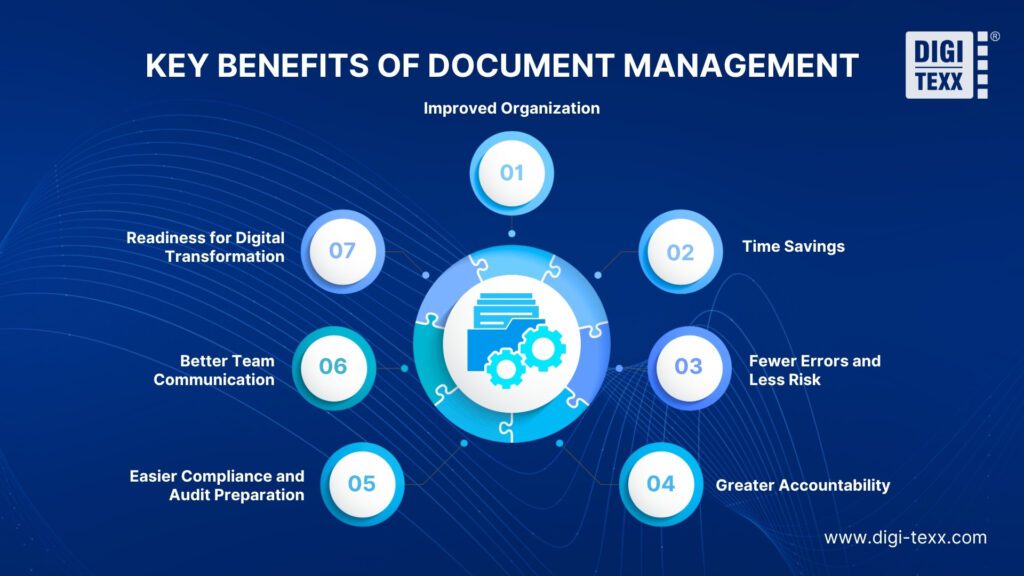
1. Improved Organization
One of the core benefits of document management is better organization. Documents that are grouped by category, properly named, and stored in the right location are easier to manage and access.
This reduces the time spent sorting through messy folders or misfiled documents. It also creates a clean structure that supports consistency across teams, even as the business grows.
2. Time Savings
Without proper document management, employees often waste hours looking for the right files. By setting up clear folder structures, consistent naming conventions, and indexing systems, businesses significantly cut down on retrieval time.
Quick access to the right documents helps employees stay focused and keep their work moving without interruptions.
3. Fewer Errors and Less Risk
Poorly managed documents can lead to serious errors such as using the wrong version of a file, missing an important update, or even losing a key record entirely. Document management helps reduce these risks by ensuring that teams always work with the most current and accurate files.
Outdated documents are clearly archived and kept separate, which is especially important when dealing with contracts, financial data, or documents in regulated environments.
4. Greater Accountability
Document management makes it easier to assign responsibility. Each document can have an owner, a defined storage location, and a review schedule. This way, it’s always clear who is responsible for keeping it up to date.
As a result, it reduces confusion, improves consistency, and ensures that nothing gets overlooked or lost in daily operations.
5. Easier Compliance and Audit Preparation
For industries with legal, financial, or data protection regulations, document management plays a crucial role. It helps businesses apply retention rules, track access, and organize records in a way that supports audits.
Even for businesses without strict regulations, having clean, traceable documentation builds credibility and reduces legal risks.
6. Better Team Communication
When documents are properly organized and easy to access, collaboration between teams becomes much more efficient. Instead of constantly checking in with others to confirm which version is the most up-to-date or where a particular file is stored, team members can work independently.
Everyone works from the same document in the same location, reducing duplication, miscommunication, and errors. This consistency helps teams collaborate more smoothly and keeps projects moving without delays.
7. Readiness for Digital Transformation
Businesses that already follow strong document management practices, even with paper-based systems, are in a much better position to transition to digital later on. When files are clearly labeled, properly categorized, and reviewed regularly, they are much easier to scan, upload, and integrate into digital platforms. This helps make future transitions faster, smoother, and more cost-effective.
Such readiness is a key foundation for successful Digital Document Transformation, enabling companies to digitize their workflows with minimal disruption.
Common Document Management Challenges
Document management, whether on paper or in digital form, can create unexpected difficulties if not handled properly. These challenges often lead to inefficiencies, security risks, compliance issues, and communication breakdowns across teams.
Below are the common challenges that organizations face when managing documents.
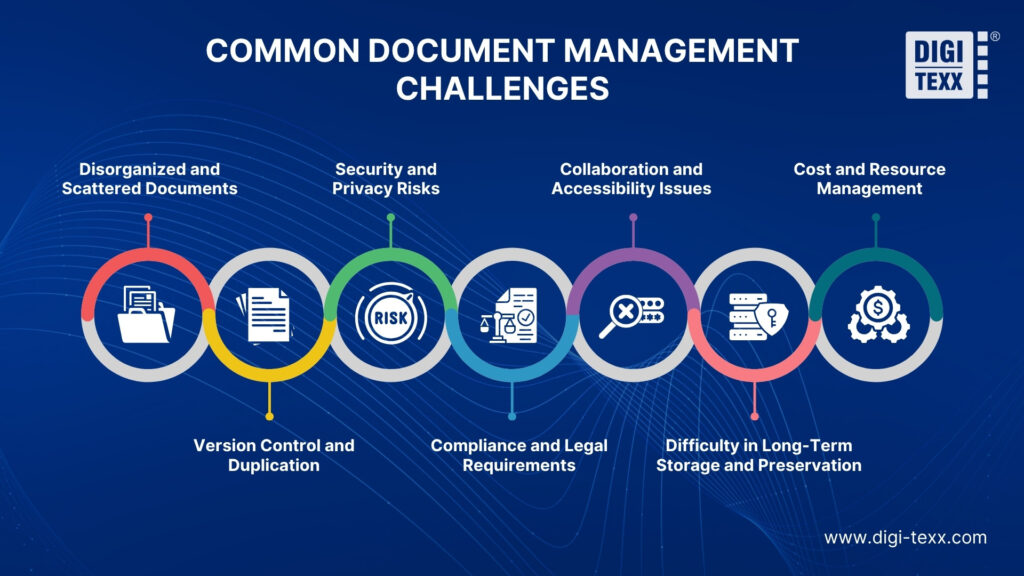
1. Disorganized and Scattered Documents
In many businesses, documents are stored in too many different places. Some are saved on personal computers, others in email threads, and some in shared drives, cloud folders, or even in physical cabinets..
Without a central structure, it becomes hard to know where a document is or which version is the correct one. Employees often waste time searching for files, and teams may end up working on outdated or duplicated content.
2. Version Control and Duplication
Without clear version tracking, it is easy for multiple versions of the same document to exist at the same time. Team members might make changes to different copies, causing confusion and inconsistency.
In some cases, people recreate documents from scratch simply because they cannot find the latest version. This leads to duplicated efforts and wasted time. To fix this, many organizations use data deduplication services to remove duplicates and keep only the latest versions.
3. Security and Privacy Risks
When document access is not properly controlled, sensitive information can end up in the wrong hands. Some employees may view or edit files they should not have access to.
If audit trails are missing, it becomes impossible to know who accessed or changed a document. Poorly secured files are also vulnerable to cyber threats such as hacking or ransomware attacks.
4. Compliance and Legal Requirements
Many industries have strict regulations on how documents must be stored, accessed, and retained. Without a well-organized system, it is hard to ensure compliance with laws such as GDPR or HIPAA.
Businesses may struggle to locate files during audits or fail to delete documents after the required retention period, which can lead to legal or financial penalties.
5. Collaboration and Accessibility Issues
When documents are hard to access or not updated in real time, it becomes difficult for teams to collaborate effectively. Some businesses still rely on exchanging documents via email, which often leads to version confusion and delays.
In remote or hybrid workplaces, the lack of secure online access makes it harder for distributed teams to work together smoothly.
6. Difficulty in Long-Term Storage and Preservation
Documents that are not stored properly can be lost, damaged, or become unusable over time. Paper files may fade, tear, or be destroyed in a fire or flood. Digital files may get corrupted or become unreadable if stored in outdated formats.
Without a strategy for long-term preservation, important records can disappear when they are needed most.
7. Cost and Resource Management
Managing documents comes with both visible and hidden costs. For businesses still handling physical paperwork, expenses can include renting storage cabinets, maintaining archive rooms, or paying for off-site records storage.
On the other hand, going digital also requires investment, such as purchasing a Document Management System (DMS), setting up secure servers, and training staff to use new tools.
Without careful planning, these costs can quickly grow without delivering real efficiency or return on investment.
Popular Industries That Need Document Management
Document management is not just about storing files; it’s about ensuring information is accessible, secure, and reliable throughout every stage of a business process. Below are key industries where document management is a vital part of daily operations and long-term success.
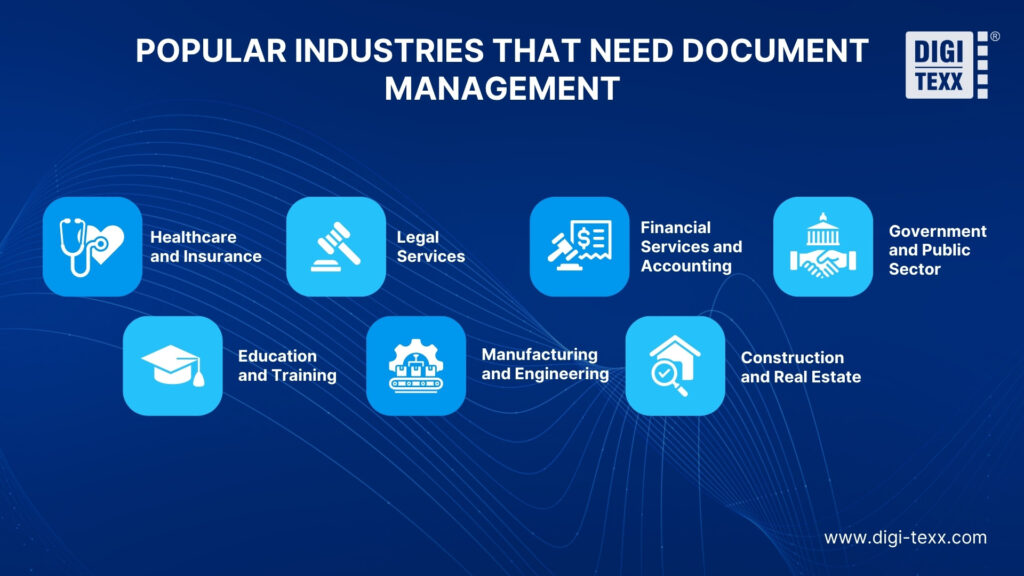
1. Healthcare and Insurance
In healthcare, every decision depends on accurate, up-to-date documentation. Medical records, prescriptions, lab results, discharge summaries, and insurance claims all need to be stored securely and accessed quickly.
Without proper document management, critical patient information may be delayed, misplaced, or exposed to privacy risks. Similarly, insurance providers must handle a high volume of claim forms, policy documents, and communications that must be traceable, compliant, and ready for audits.
An organized document will help streamline care, speed up approvals, and ensure legal compliance.
2. Legal Services
Law firms manage thousands of documents for each case, including contracts, legal briefs, evidence, client correspondence, and court filings. These documents must be stored securely, tracked accurately, and retrieved quickly, especially when deadlines are tight.
Without clear document management, version confusion or misplaced files can seriously impact a case or harm the firm’s reputation. A well-organized approach ensures smooth collaboration, reliable version control, strong confidentiality, and fast access, all of which are essential in the legal field.
3. Financial Services and Accounting
This industry is driven by trust, accuracy, and regulation. Banks, credit unions, and accounting firms must manage financial statements, client records, audit files, tax returns, and compliance documents.
These files must be stored long-term and remain tamper-proof and easily retrievable. Document management helps maintain transparency, ensure data accuracy, support faster audits, and reduce the risk of errors or fraud.
4. Government and Public Sector
Public agencies generate a large volume of records, such as citizen information, contracts, permits, policies, and correspondence. These documents often have strict retention requirements and need to be available for audits or public access.
Poor document control can lead to legal risks, loss of institutional knowledge, or damage to public trust. Document management improves recordkeeping, speeds up internal processes, and supports accountability in governance.
5. Education and Training
Schools, universities, and training centers handle a broad mix of documents, including student records, class materials, exam results, degrees, and faculty evaluations. Managing this information manually can be time-consuming and prone to errors.
A structured document management process ensures that data is organized, secure, and accessible to staff, students, and administrators when needed, supporting smoother operations and compliance with academic standards.
6. Manufacturing and Engineering
This sector depends heavily on documentation for operations, compliance, and safety. Specifications, product drawings, work instructions, maintenance logs, and inspection reports must be version-controlled and easily accessible on the production floor.
Outdated documents can lead to production delays, quality issues, or safety hazards. Document management ensures that every team, from design to QA, works with accurate and current information.
7. Construction and Real Estate
Construction and real estate projects involve a wide range of documents: blueprints, permits, site reports, legal contracts, environmental assessments, and progress photos. These documents must be updated regularly, shared between multiple parties, and preserved for years after project completion.
Without proper document management, teams risk miscommunication, project delays, or legal disputes. A centralized system helps track changes, ensure compliance, and improve collaboration across all phases of a project.
Make Document Management Work Productively
Document management is more than just organizing paperwork or sorting digital files; it’s about giving your team better access to the right information, at the right time, in the right format.
When done well, it helps businesses reduce clutter, improve accuracy, streamline workflows, and stay compliant with ease. Both physical and digital documents require care and structure.
For physical files, that means clear categorization, secure storage, and timely disposal. For digital records, it means consistent naming, centralized access, backups, and the right tools like a Document Management System (DMS). Together, these practices help teams save time, avoid costly mistakes, and work with greater confidence.

At DIGI-TEXX, we’ve shared the essentials to help you get started. If you still have questions or want to explore specific practices for your business, feel free to reach out — we’re always happy to help.
=> Read more:


